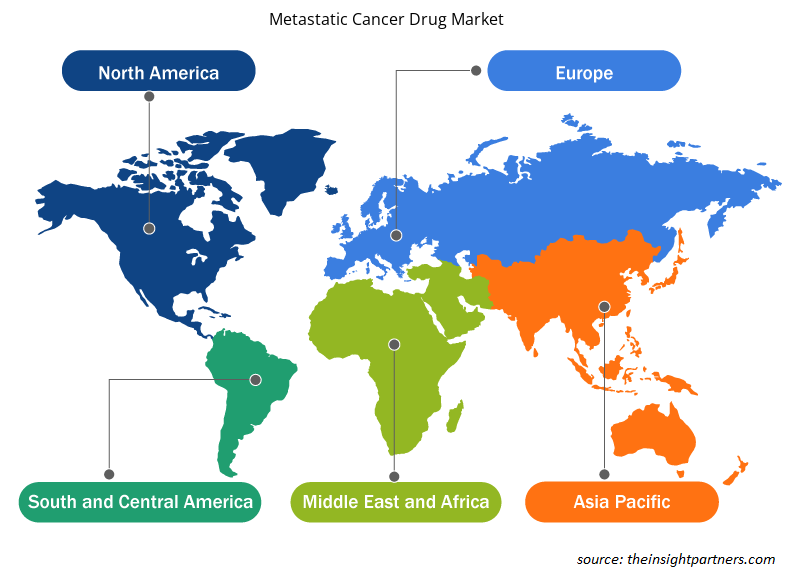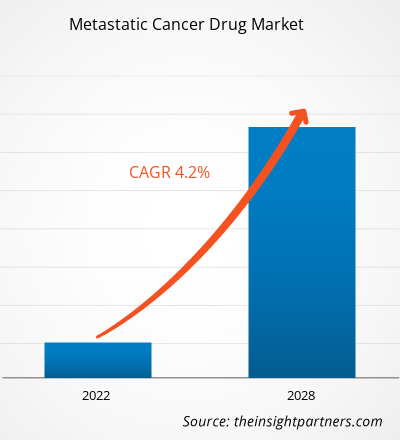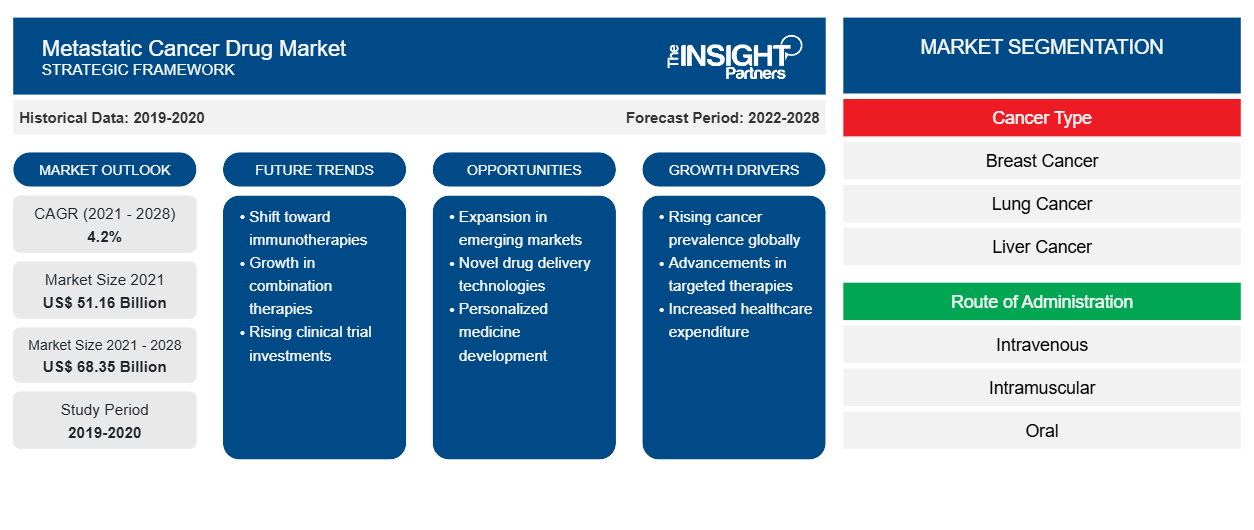[Forschungsbericht] Der Markt für Medikamente gegen metastasierenden Krebs soll von 51.157,97 Millionen US-Dollar im Jahr 2021 auf 68.349,54 Millionen US-Dollar im Jahr 2028 anwachsen. Von 2021 bis 2028 wird mit einer durchschnittlichen jährlichen Wachstumsrate von 4,2 % gerechnet.
Metastasierter Krebs ist definiert als Krebs im fortgeschrittenen Stadium, der sich auf andere Körperteile ausbreitet. Die Medikamente, die zur Behandlung von Krebs im fortgeschrittenen Stadium verwendet werden, heißen metastasierte Krebsmedikamente. Diese Medikamente werden in verschiedenen Therapien eingesetzt, beispielsweise Chemotherapie, Immuntherapie und zielgerichtete Therapie.
Der Markt für Medikamente gegen metastasierenden Krebs wird anhand von Krebsart, Verabreichungsweg, Medikamentenklasse, Produkt, Endverbraucher und Geografie analysiert. Der Markt ist geografisch grob in Nordamerika, Europa, Asien-Pazifik, den Nahen Osten und Afrika sowie Süd- und Mittelamerika unterteilt. Der Bericht bietet Einblicke und eine eingehende Analyse des Marktes und betont Parameter wie die Größe des Marktes für Medikamente gegen metastasierenden Krebs, Trends, technologische Fortschritte und Marktdynamik sowie die Analyse der Wettbewerbslandschaft der weltweit führenden Marktteilnehmer.
Passen Sie diesen Bericht Ihren Anforderungen an
Sie erhalten kostenlose Anpassungen an jedem Bericht, einschließlich Teilen dieses Berichts oder einer Analyse auf Länderebene, eines Excel-Datenpakets sowie tolle Angebote und Rabatte für Start-ups und Universitäten.
- Holen Sie sich die wichtigsten Markttrends aus diesem Bericht.Dieses KOSTENLOSE Beispiel umfasst eine Datenanalyse von Markttrends bis hin zu Schätzungen und Prognosen.
Der Markt für Medikamente gegen metastasierenden Krebs ist auf die hohe Prävalenz von metastasierendem Krebs und staatliche Initiativen zur Förderung der Entwicklung in der Krebsbehandlung zurückzuführen. Die hohen Kosten für Onkologiemedikamente schränken jedoch das Wachstum des Marktes für Medikamente gegen metastasierenden Krebs ein.
Markteinblicke
Hohe Prävalenz von metastasiertem Krebs
Krebs ist eine der Erkrankungen, die Gesellschaften weltweit erheblich beeinträchtigen. Nach Angaben des National Institute of Cancer erkrankten im Jahr 2020 in den USA 1.806.590 Menschen an Krebs, während 606.520 Menschen an Krebs starben. Nach Angaben des American Institute of Cancer Research waren im Jahr 2020 weltweit 18.100 Fälle aktiv. Darüber hinaus gab die Weltgesundheitsorganisation (WHO) an, dass 10.000 Todesfälle oder 1 von 6 Todesfällen weltweit auf Krebs zurückzuführen sind. Die häufigsten Krebsarten sind Lungenkrebs, Brustkrebs, Dickdarmkrebs, Mastdarmkrebs und Prostatakrebs. Die Krankheit tritt jedes Jahr bei 400.000 Kindern auf. Karzinogene Infektionen – darunter Helicobacter pylori, Hepatitis-B-Virus, humanes Papillomavirus (HPV), Hepatitis-C-Virus und Epstein-Barr-Virus – verursachten 2018 weltweit 13 % der Krebsfälle. Die Internationale Agentur für Krebsforschung (IARC) geht davon aus, dass die Zahl der neuen Krebserkrankungen und krebsbedingten Todesfälle weltweit bis 2040 um das 1,6- bis 1,7-Fache ansteigen wird und von 16,4 Millionen im Jahr 2018 auf 29,5 Millionen ansteigen wird. Darüber hinaus wurde laut der American Society of Clinical Oncology im Jahr 2021 in den USA bei 290.560 Menschen (287.850 Frauen und 2.710 Männer) invasiver Brustkrebs diagnostiziert. Brustkrebs bei Frauen hat mittlerweile Lungenkrebs überholt und gilt weltweit als die häufigste Krebsart. Im Jahr 2020 wurde bei etwa 2.261.419 Frauen Brustkrebs diagnostiziert.papillomavirus (HPV), hepatitis C virus, and Epstein-Barr virus—caused 13% of cancer cases in 2018, globally. The International Agency for Research on Cancer (IARC) projects that the number of new cancer cases and cancer-related deaths worldwide will grow 1.6–1.7 fold by 2040 to reach 29.5 million and from 16.4 million in 2018. Further, according to the American Society of Clinical Oncology, in 2021, 290,560 people (287,850 women and 2,710 men) in the US were diagnosed with invasive breast cancer. Breast cancer in females has now surpassed lung cancer and is recognized as the most common cancer type worldwide. Approximately, 2,261,419 women were diagnosed with breast cancer in 2020.
Unter all den Beobachtungen, die in den letzten Jahrzehnten in den USA über Krebs aufgezeichnet wurden, ist eine Statistik unverändert geblieben: Metastasierter Krebs ist für bis zu 90 % aller Krebstodesfälle pro Jahr verantwortlich. Diese Zahlen haben Ärzte und Forscher motiviert, neue Wege zur Behandlung von Metastasen zu finden, die auftreten, wenn sich Krebs über seinen Ursprungsort hinaus ausbreitet. In den USA wurde bei 6 % der Frauen bei der Erstdiagnose metastasierter Brustkrebs diagnostiziert. Ein solcher Anstieg der Prävalenz von metastasiertem Krebs treibt das Wachstum des Marktes für Medikamente gegen metastasierten Krebs voran.
In Nordamerika wird für Kanada im Prognosezeitraum ein beträchtliches Wachstum erwartet. Die wichtigsten in Kanada verwendeten Immuntherapiemedikamente sind Ipilimumab (Yervoy), Pembrolizumab (Keytruda), Nivolumab (Opdivo), Durvalumab (Imfinzi) und Atezolizumab (Tecentriq). Es gibt jedoch auch andere Checkpoint-Inhibitoren, die für das allgemeine Marktwachstum sorgen dürften.immunotherapy drugs used in Canada are ipilimumab (Yervoy), pembrolizumab (Keytruda), nivolumab (Opdivo), durvalumab (Imfinzi) and atezolizumab (Tecentriq). However, there are other checkpoint inhibitors poised to bring the overall market growth.
Erkenntnisse auf Basis der Krebsart
Basierend auf der Krebsart ist der Markt für Medikamente gegen metastasierenden Krebs in Brustkrebs, Lungenkrebs, Leberkrebs , hämatologischen Krebs , Hirnkrebs, Prostatakrebs, Bauchspeicheldrüsenkrebs und andere unterteilt. Das Brustkrebssegment hatte 2021 den größten Marktanteil und wird im Prognosezeitraum voraussichtlich die höchste durchschnittliche jährliche Wachstumsrate verzeichnen.CAGR during the forecast period.
Einblicke auf Grundlage der Verabreichungswege
Basierend auf der Verabreichungsart ist der Markt für Medikamente gegen metastasierenden Krebs in intravenöse, intramuskuläre, orale und andere unterteilt. Das intravenöse Segment hatte 2021 den größten Marktanteil und wird im Prognosezeitraum voraussichtlich die höchste durchschnittliche jährliche Wachstumsrate verzeichnen.CAGR during the forecast period.
Erkenntnisse auf Basis von Arzneimittelklassen
Basierend auf der Medikamentenklasse ist der Markt für Medikamente gegen metastasierenden Krebs in HER2-Inhibitoren, Immuncheckpoint-Inhibitoren , PARP-Inhibitoren, Kinase-Inhibitoren und andere unterteilt. Das Segment der PARP-Inhibitoren hatte 2021 den größten Marktanteil. Es wird jedoch erwartet, dass das Segment der HER2-Inhibitoren im Prognosezeitraum die höchste durchschnittliche jährliche Wachstumsrate verzeichnet.PARP inhibitors, kinase inhibitors, and others. The PARP inhibitors segment accounted for the largest market share in 2021. However, the HER2 inhibitors segment is expected to register the highest CAGR during the forecast period.
Regionale Einblicke in den Markt für Medikamente gegen metastasierten Krebs
Die regionalen Trends und Faktoren, die den Markt für Medikamente gegen metastasierten Krebs im Prognosezeitraum beeinflussen, wurden von den Analysten von Insight Partners ausführlich erläutert. In diesem Abschnitt werden auch die Marktsegmente und die Geografie von Medikamenten gegen metastasierten Krebs in Nordamerika, Europa, im asiatisch-pazifischen Raum, im Nahen Osten und Afrika sowie in Süd- und Mittelamerika erörtert.

- Erhalten Sie regionale Daten zum Markt für Medikamente gegen metastasierten Krebs
Umfang des Marktberichts über Medikamente gegen metastasierten Krebs
| Berichtsattribut | Details |
|---|---|
| Marktgröße im Jahr 2021 | 51,16 Milliarden US-Dollar |
| Marktgröße bis 2028 | 68,35 Milliarden US-Dollar |
| Globale CAGR (2021 - 2028) | 4,2 % |
| Historische Daten | 2019-2020 |
| Prognosezeitraum | 2022–2028 |
| Abgedeckte Segmente | Nach Krebsart
|
| Abgedeckte Regionen und Länder | Nordamerika
|
| Marktführer und wichtige Unternehmensprofile |
|
Dichte der Marktteilnehmer für Medikamente gegen metastasierenden Krebs: Auswirkungen auf die Geschäftsdynamik verstehen
Der Markt für Medikamente gegen metastasierten Krebs wächst rasant. Dies wird durch die steigende Nachfrage der Endverbraucher aufgrund von Faktoren wie sich entwickelnden Verbraucherpräferenzen, technologischen Fortschritten und einem größeren Bewusstsein für die Vorteile des Produkts vorangetrieben. Mit der steigenden Nachfrage erweitern Unternehmen ihr Angebot, entwickeln Innovationen, um die Bedürfnisse der Verbraucher zu erfüllen, und nutzen neue Trends, was das Marktwachstum weiter ankurbelt.
Die Marktteilnehmerdichte bezieht sich auf die Verteilung von Firmen oder Unternehmen, die in einem bestimmten Markt oder einer bestimmten Branche tätig sind. Sie gibt an, wie viele Wettbewerber (Marktteilnehmer) in einem bestimmten Marktraum im Verhältnis zu seiner Größe oder seinem gesamten Marktwert präsent sind.
Die wichtigsten auf dem Markt für Medikamente gegen metastasierten Krebs tätigen Unternehmen sind:
- AbbVie Inc.
- Amgen Inc.
- Bristol-Myers Squibb Company
- F. HOFFMANN-LA ROCHE LTD.
- Novartis AG
Haftungsausschluss : Die oben aufgeführten Unternehmen sind nicht in einer bestimmten Reihenfolge aufgeführt.

- Überblick über die wichtigsten Akteure auf dem Markt für Medikamente gegen metastasierende Krebs
Produktbasierte Einblicke
Basierend auf dem Produkt ist der Markt für Medikamente gegen metastasierenden Krebs in Marken-, Generika- und Biosimilars-Produkte unterteilt. Das Markensegment hatte 2021 einen größeren Marktanteil. Es wird jedoch geschätzt, dass das Segment Generika und Biosimilars im Prognosezeitraum eine höhere durchschnittliche jährliche Wachstumsrate verzeichnen wird.
Endbenutzerbasierte Erkenntnisse
Basierend auf dem Endverbraucher ist der Markt für Medikamente gegen metastasierenden Krebs in Krankenhäuser, Fachkliniken und andere unterteilt. Das Krankenhaussegment hatte 2021 den größten Anteil, während das Segment der Fachkliniken im Prognosezeitraum voraussichtlich die höchste durchschnittliche jährliche Wachstumsrate verzeichnen wird.
Produkteinführungen und -zulassungen gehören zu den häufig angewandten Strategien von Unternehmen, um ihre globale Präsenz und ihr Produktportfolio zu erweitern. Die Akteure auf dem Markt für Medikamente gegen metastasierenden Krebs konzentrieren sich auch auf die Partnerschaftsstrategie, um ihren Kundenstamm zu vergrößern, was ihnen wiederum ermöglicht, ihren Markennamen weltweit aufrechtzuerhalten. Sie zielen darauf ab, ihre Marktanteile durch die Entwicklung innovativer Produkte auszubauen.
AbbVie Inc.; Amgen Inc.; Bristol-Myers Squibb Company; F. HOFFMANN-LA ROCHE LTD.; Novartis AG; ASTRAZENECA PLC.; Eli Lilly and Company; MERCK KGaA; und Pfizer Inc. (Arena Pharmaceutical GmbH); und Johnson and Johnson Services, Inc. sind die führenden Unternehmen auf dem Markt für Medikamente gegen metastasierenden Krebs.
- Historische Analyse (2 Jahre), Basisjahr, Prognose (7 Jahre) mit CAGR
- PEST- und SWOT-Analyse
- Marktgröße Wert/Volumen – Global, Regional, Land
- Branchen- und Wettbewerbslandschaft
- Excel-Datensatz
Aktuelle Berichte
Verwandte Berichte
Erfahrungsberichte
Grund zum Kauf
- Fundierte Entscheidungsfindung
- Marktdynamik verstehen
- Wettbewerbsanalyse
- Kundeneinblicke
- Marktprognosen
- Risikominimierung
- Strategische Planung
- Investitionsbegründung
- Identifizierung neuer Märkte
- Verbesserung von Marketingstrategien
- Steigerung der Betriebseffizienz
- Anpassung an regulatorische Trends





















 Kostenlose Probe anfordern für - Markt für Medikamente gegen metastasierten Krebs
Kostenlose Probe anfordern für - Markt für Medikamente gegen metastasierten Krebs